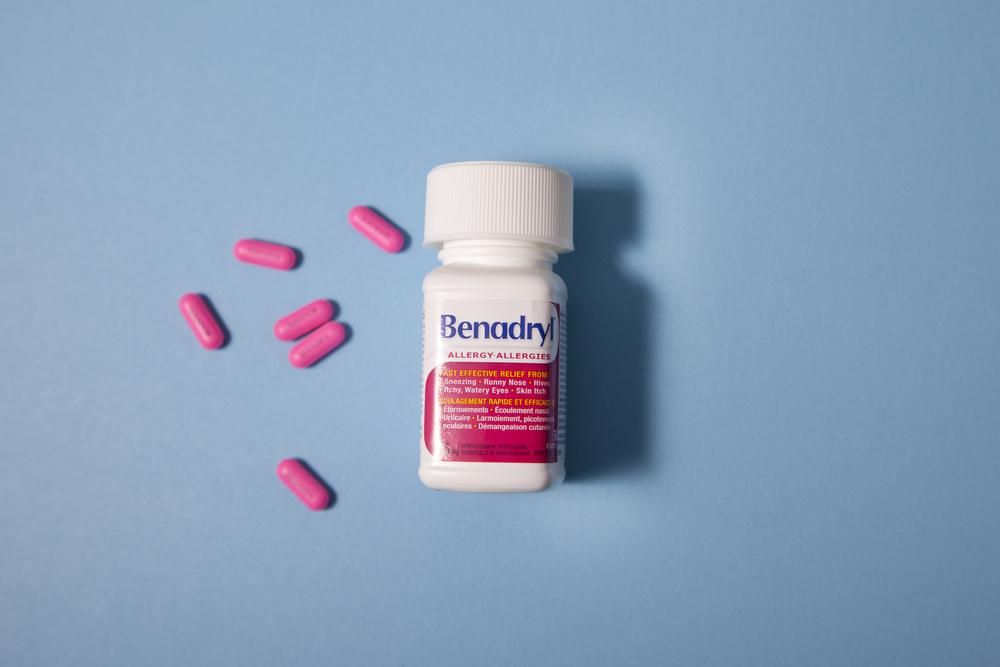Like most medications, Benadryl works by combining one primary active ingredient with several other inactive ingredients. Inactive ingredients are used to ensure that the active ingredient is properly introduced to and absorbed by the body. Making the medication all the more safe and effective.
Here’s how it works.
Benadryl’s Active Ingredient
The active ingredient among the most popular form of Benadryl (Benadryl Allergy ULTRATAB) is diphenhydramine HCI. This form of Benadryl contains twenty five milligrams of it. Diphenhydramine HCI is an antihistamine that is specifically used to relieve cold, allergy, and allergic rhinitis symptoms. While it is very effective at treating the symptoms, it will not treat the cause or speed up the recovery process of the ailment.
Because of its active ingredient, Benadryl can be used to relieve symptoms like irritated eyes, sneezing, runny nose, and congestion.
Benadryl’s Inactive Ingredients
The typical amount of active ingredients that can be found in any given medication is about nine. In Benadryls case, there are ten. Each ingredient has its own specific purpose and most of them can be found as inactive ingredients in other various medications as well. Here is a list of Benadryl’s inactive ingredients and an explanation of their purpose:
Hypromellose
Known as the most common type of cellulose, this ingredient controls the release of the active ingredient in order to allow the medication to work for longer periods of time. By withholding the release of the active ingredient, hypromellose aids benadryl in providing relief that consistently lasts while still allowing the medication to set in quickly.
Croscarmellose Sodium
Since this medication is in the form of a tablet, it needs croscarmellose sodium to help it dissolve. This ingredient is a type of salt that creates a chain of cellulose, causing the tablet to dissolve quickly once it enters the stomach. Ultimately allowing the medication to take effect more quickly.
Titanium Dioxide
Titanium Dioxide is a natural mineral that is utilized in the construction of many medications to create the pigment which coats the tablets.
Microcrystalline Cellulose
Microcrystalline cellulose is an excipient specifically used to make medication tablets hard, yet dissolvable.
Carnauba Wax
The main purpose of carnauba wax is to make tablets and pills easier to swallow. It gives tablets a slippery coating with the use of fatty acid esters.
Polysorbate 80
Polysorbate can be found in medications like Benadryl for its ability to stabilize the medications effects and allow it to be properly absorbed in the stomach. On top of being used as an excipient, Polysorbate 80 is also known to function as a solubilizing agent.
D&C Red no. 27 Aluminum Lake
This is a specific type of synthetic dye that gives Benadryl its specific color. Lake dyes are made by combining various straight dyes with various salts. In this case the straight dye is D&C no. 27 and the salt is aluminum.
Polyethylene Glycol
This specific ingredient can be used as an inactive ingredient for all sorts of different purposes. Some of these purposes include plasticiser, solvent, lubricant, and surfactant. In the case of Benadryl, polyethylene glycol is being used as a lubricant making the tablets easier for you to swallow.
Magnesium Stearate
Magnesium stearate is used as a regulatory inactive ingredient among many different types of medications. It is a flow agent that keeps ingredients within the medication from sticking to other ingredients within the medication. It also prevents the ingredients from sticking to the machine that creates the medication.
This ingredient also regulates productivity of the medication by ensuring that the active ingredient is broken down and absorbed properly.
Dibasic Calcium Phosphate
Dibasic Calcium Phosphate can be found in several different medications. This diluent allows medications to become large enough to handle. Without it, Benadryl would be much too small to handle.
Summary
Benadryl treats allergy and cold symptoms like irritated or itchy eyes, congestion, and runny nose. It does this by combining one active ingredient with ten other inactive ingredients. The inactive ingredients work alongside the active ingredient to ensure that the medication is introduced to the body properly and functions correctly once it is absorbed.
Benadryls active ingredient is diphenhydramine HCI, and its inactive ingredients are as follows: Hypromellose, Croscarmellose Sodium, Titanium Dioxide, Microcrystalline Cellulose, Carnauba Wax, Polysorbate 80, D&C Red no. 27 Aluminum Lake, Polyethylene Glycol, Magnesium Stearate, and Dibasic Calcium Phosphate.
Sources:














